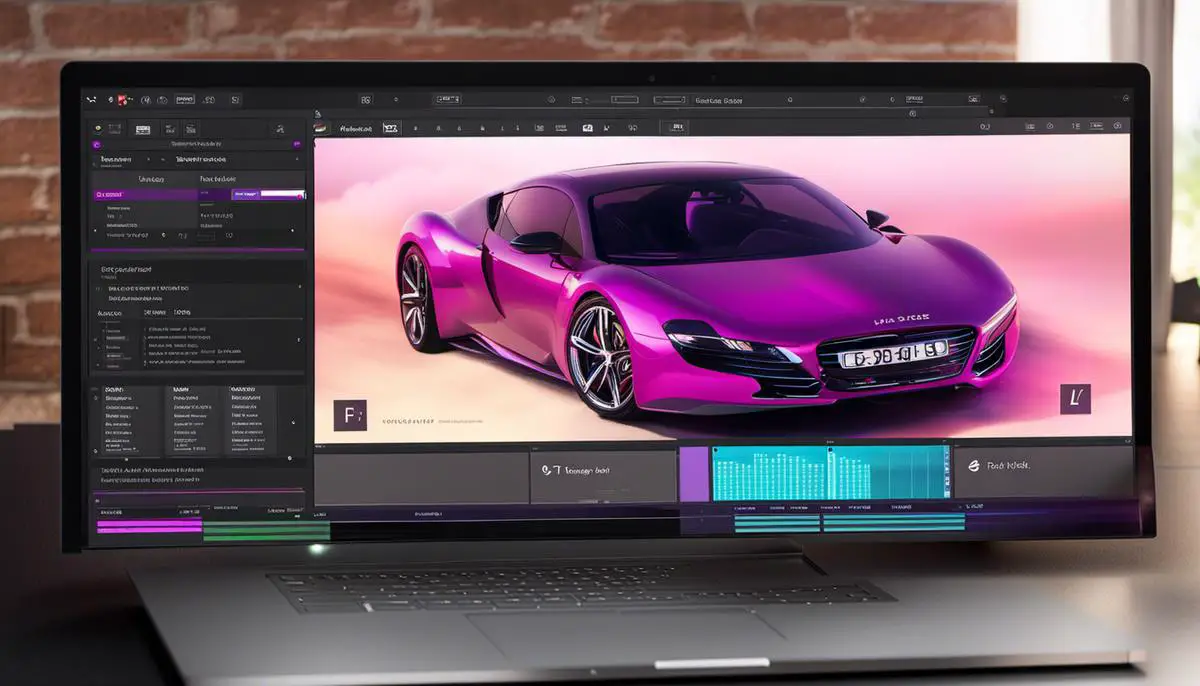In this fast-paced, digital world, creating engaging and visually striking content becomes a vital skill for many. With the powerful tool like Adobe After Effects, an artist’s creativity can know no bounds. Offering a comprehensive set of animation, keyframes, visual effects, and presets paired with 3D features, After Effects allows the creation of anything your mind can imagine. This discussion kicks off by steering through the basics to understand Adobe After Effects’ interface, its tools, panels, and effects. It further expands into the core mechanics of animation using keyframes, enhancing projects using presets and effects, and understanding the 3D features and related rendering techniques in After Effects.
Introduction to Adobe After Effects
Introduction to Adobe After Effects Interface
Adobe After Effects is primarily used for creating motion graphics and visual effects. It allows you to animate, edit, and compose media in 2D or 3D space. Its interface consists of several panels (Project panel, Composition panel, Timeline panel, etc.) which are grouped in one or more windows. Sensitively organized, you can customize the layout in a way that best works for you.
Understanding the Tools, Panels, and Effects
The Tools panel contains various tools for creating and editing shapes, texts, paths, and more. The Project panel is used to manage and organize your project’s assets, while the Composition panel offers a preview of the composition you’re working on. In the timeline panel, you can manage and view the layers and effects, and adjust the timeline of each layer.
Once you’ve learnt to navigate these panels, you need to explore the vast number of effects available in After Effects. The Effects & Presets panel is where you can access these. Commonly used effects include 3D, Distort, Generate, Style, and Text. Each of these categories contains several specific effects that can be applied to your layers.
Workflows in Adobe After Effects
The workflow in Adobe After Effects typically involves the following steps: creating a project and importing footage, creating a composition and arranging layers, adding effects, animating elements, previewing your work, and rendering the final composition. Though seemingly complex, following a structured workflow can actually make your design process smoother and more efficient.
Importing and Organizing Media
After Effects supports many types of media files. Under the File menu, select Import to bring your media files into the project. In the Import File dialog box that appears, you can choose the media file you want to import. Once imported, these files appear in the Project panel from where you can drag them into a composition.
For organization, you can create folders in the Project panel and rename your assets to keep your project tidy. You can even color code your layers for better visualization and organization.
By getting a hang of these basic features, you can lay a solid foundation for your After Effects skill set. With understanding and regular practice, you will soon be able to create visually dynamic and expressive motion graphics.

Animation & Keyframes
Understanding the Basics of Animation & Keyframes in Adobe After Effects
Adobe After Effects (AE) utilizes keyframes to create animation effects. A keyframe indicates the point in time where you specify a value for an AE layer property such as opacity, position, or scale etc. By default, property values do not change; however, when you change a layer property with the keyframe feature, After Effects interpolates the values between the keyframes for you.
Creating Keyframes
To start creating animations using keyframes, follow these steps:
- Import your video, image, or composition to the AE timeline.
- Select the layer you want to animate.
- Choose the property you want to animate (e.g., opacity, position, scale).
- Move the timeline playhead to the ideal point where you want the animation to start.
- Click on the stopwatch icon next to the property name. This will create the first keyframe.
- Move the playhead to the point where the animation should end, change the property value as per your needs. This will automatically create another keyframe.
Managing and Applying Animations Using Keyframes
AE provides multiple tools to manage and apply these animations:
- To copy keyframes, simply select the keyframes and press “Control+C” or “Command+C”.
- To paste keyframes, move your playhead to the desired position and press “Control+V” or “Command+V”.
- To move keyframes, select the keyframes and drag them to a new position along the timeline. The value will remain the same.
Utilizing the Speed Graph Editor, Easy Ease, and Other Keyframe Types
AE gives you precise control over the speed and timing of animations:
- Speed Graph Editor: This tool helps you visualize how your animations are changing speed over time. To see the speed graph, select the layer and click on the graph editor button. Switch from the value graph to the speed graph using the ‘choose graph type’ button.
- Easy Ease: This function allows for smoother transitions between keyframes. To apply this, select a keyframe, right click, go to “Keyframe Assistant” and select “Easy Ease”.
- Keyframe Types: AE has different keyframe types. Linear Keyframes result in consistent movement, while Bezier Keyframes allow you to create more organic movement paths.
Knowing how to create, apply, and manage animations using keyframes in Adobe After Effects allows for captivating and dynamic visual effects. Mastering the speed-graph editor, easy ease, and different keyframe types will further enhance your animation expertise.

Effects & Presets
Understanding Effects & Presets in Adobe After Effects
Adobe After Effects has a feature called ‘Effects & Presets,’ which allows users to apply various visual and audio effects to enhance their projects. Accentuate scenes, add intensity, or soften impact with color schemes, blurs, and many more. Save your effect controls as presets to apply them to other parts of your project or future compositions, and streamline efficiency.
Utilizing the Customization of Presets
To use a preset, navigate to the Effects & Presets panel accessible from the toolbar or the ‘Windows’ dropdown in the upper navigation bar. Choose a preset by browsing or using the search feature, and drag it to the desired layer in the composition panel. Customize settings by clicking on the applied effect in the layer panel, which will open its parameters in the Effect Controls panel.
Creating Presets
To create a preset, first, add and modify the effects you want to a layer. Once satisfied with the settings, select the effects in the Effect Controls Panel. Then go to ‘Animation > Save Animation Preset.’ The new preset will be accessible under ‘User Presets’ in the Effects & Presets panel.
Understanding Blending Modes and Layer Styles
Blending modes adjust how layers blend with the layers beneath them, affecting color and brightness. Available blending modes are accessible from the dropdown list in the mode column of the layer panel. A subtle blend can make significant differences in creating mood-specific visuals.
Layer styles apply visual effects, such as a drop shadow or stroke, directly to the layer content. Styles can be added by choosing ‘Layer > Layer Styles,’ followed by your desired style.
Applying Color Correction Effects
Color correction effects help adjust color balance or reproduce the look of film processes. To apply color correction effects, go to the Effects & Presets panel, find the ‘Color Correction’ folder, and drag and drop the desired effect onto a composition layer.
Mastering the Effect Controls Panel
The Effect Controls panel displays all the effects applied to a selected layer. Each effect lists parameters that can be adjusted, keyframed, or expression-rigged. Understanding the various parameters and how they change your visual presentation is critical in achieving desired results.
Exploring Visual Effects in Adobe After Effects
Adobe After Effects offers numerous visual effects divided into categories in the Effects & Presets panel. The ‘Generate’ category, for instance, includes effects that can generate visuals from scratch, such as gradients or fractal noise. Other categories like ‘Distort’ and ‘Warp’ offer effects for morphing and distorting layers. Familiarize yourself with the range of effects to maximize your project’s visual potential.

3D Features & Render
Understanding The 3D features in After Effects
Adobe After Effects is equipped with powerful tools to create 3D animations and motion graphics, starting with 3D layers. When a layer is made 3D, you have the ability to move it in a three-dimensional space. Make a layer 3D by selecting the layer and clicking the ‘cube’ icon in the layer’s panel to toggle it into a 3D layer. Doing so will reveal additional properties such as x, y, and z rotation and positioning to give the object depth and dimension.
Working with Camera and Light
The camera tool is another vital component in creating 3D effects. This feature allows users to take a dynamic viewpoint of their 3D scene. You can select the camera tool from the toolbar or hit ‘C’ on your keyboard. Manipulating camera angles gives a realistic feel to the 3D objects in your videos.
Lighting is as essential in After Effects as it is in the real world. Different types of lights such as point light, spotlight, parallel light, and ambient light can be added to your composition from the ‘Layer’ > ‘New’ > ‘Light’ option. You’ll see options to customize the light properties like intensity, cone angle, color, and others.
Animating in 3D
Animating objects in 3D space involves changing position or rotation along the z-axis. With the 3D layer selected, hit ‘P’ to open up the position property or ‘R’ for the rotation property. Create a keyframe at the beginning of the timeline for the current position, and then move the time cursor and adjust the position or rotation properties to your liking. Create a new keyframe, and After Effects will animate the transition between the points.
Rendering and Exporting 3D Projects
Rendering and exporting are the final steps in your After Effects project. To ensure best quality and performance, Adobe Media Encoder is a great tool that works in tandem with After Effects. To render, go to ‘Composition’ > ‘Add to Adobe Media Encoder Queue’. Your composition will open in the Adobe Media Encoder. When your project loads in Adobe Media Encoder, you will have the options to choose format, preset and output location for your render.
A high-quality option for video render is H.264. Choose the preset that matches your desired resolution, usually ‘Match Source – High bitrate’. In the output file, navigate to your save destination, then click the green play button on the top right to start rendering.
Keep in mind that rendering and exporting may take several minutes or even hours depending on the complexity of your project. The ideal settings for rendering might differ based on specific project requirements or system capabilities. Hence, it’s recommended to experiment and find the settings that work best for you.

After delving into this exploration of Adobe After Effects, it becomes clear how this dynamic tool aids in creating stunning multimedia projects. From setting up the platform, implementing animations, stylizing with presets, to painting in 3D dimensions, every feature contributes towards a more refined and enhanced output. Armed with this knowledge, you are now equipped to utilize After Effects to its maximum potential, render your creative visions into reality, and elevate your multimedia projects to new heights. Moving forward, may your creative adventures in the digital world be fruitful and information-rich with Adobe After Effects.
Animation Easing: A Guide to Creating Smooth and Natural Animations
Free Software for Video Editing
Arsalan Malik is a passionate Software Engineer and the Founder of Makemychance.com. A proud CDAC-qualified developer, Arsalan specializes in full-stack web development, with expertise in technologies like Node.js, PHP, WordPress, React, and modern CSS frameworks.
He actively shares his knowledge and insights with the developer community on platforms like Dev.to and engages with professionals worldwide through LinkedIn.
Arsalan believes in building real-world projects that not only solve problems but also educate and empower users. His mission is to make technology simple, accessible, and impactful for everyone.



